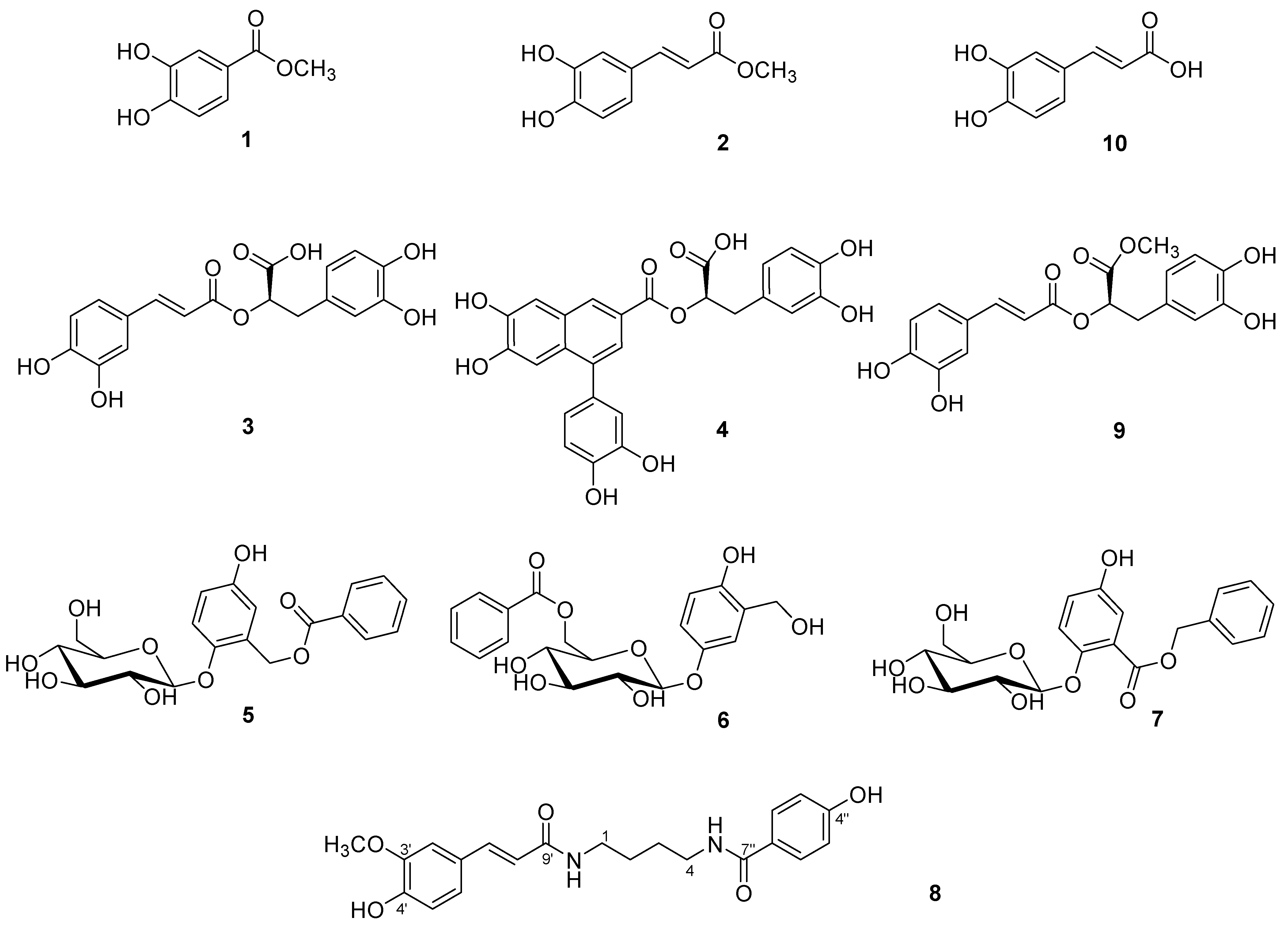A New Phenolic Amide from the Roots of Paris verticillata
Abstract
:Introduction
Results and Discussion


Biological activity
Experimental
General
Plant material
Extraction and Isolation
Test for in vitro cytotoxicity.
Acknowledgements
References
- Ahn, D. K. Illustrated book of Korean medicinal herbs; Kyo-Hak Publishing Co.: Seoul, 1998. [Google Scholar]
- Nakano, K.; Murakami, K.; Nohara, T.; Tomimatsu, T.; Kawasaki, T. The constituents of Paris verticillata M.v. Bieb. Chem. Pharm. Bull. 1981, 29, 1445–1451. [Google Scholar] [CrossRef]
- Miyazawa, M.; Oshima, T.; Koshio, K. Tyrosinase inhibitor from black rice bran. J. Agric. Food Chem. 2003, 51, 6953–6956. [Google Scholar] [CrossRef] [PubMed]
- Martic, S.; Brennan, J. D.; Brook, M. A.; Ackloo, S.; Nagy, N. Towards the development of a covalenty tethered MALDI system- a study of allyl-modified MALDI matrixed. Can. J. Chem. 2007, 85, 66–76. [Google Scholar] [CrossRef]
- Woo, E. R.; Piao, M. S. Antioxidative constituents from Lycopus lucidus. Arch. Pharm. Res. 2004, 27, 173–176. [Google Scholar] [CrossRef] [PubMed]
- Ovenden, S. P. B.; Yu, J.; Wan, S. S.; Sberna, G.; Tait, R. M.; Rhodes, D.; Cox, S.; Coates, J.; Walsh, N. G.; Meurer-Grimes, B. M. Globoidnan A: a lignan from Eucalyptus globoides inhibits HIV integrase. Phytochemistry 2004, 65, 3255–3259. [Google Scholar] [CrossRef] [PubMed]
- Ahmad, V. U.; Abbasi, M. A.; Hussain, H.; Akhtar, M. N.; Farooq, U.; Fatima, N.; Choudhary, M. I. Phenolic glycosides from Symplocos racemosa: natural inhibitors of phosphodiesterase I. Phytochemisty 2003, 63, 217–220. [Google Scholar] [CrossRef]
- Cordell, G. A.; Chang, P. T. O.; Fong, H. H. S.; Farnsworth, N. R. Xylosmacin, a new phenolic glucoside ester from Xylosma velutina (Flacourtiaceae). Lloydia 1977, 40, 340–343. [Google Scholar] [PubMed]
- Dommisse, R. A.; Van Hoof, L.; Vlietinck, A. J. Structural analysis of phenolic glucosides from Salicaceae by NMR spectroscopy. Phytochemistry 1986, 25, 1201–1204. [Google Scholar] [CrossRef]
- Saito, N.; Tatsuzawa, F.; Yazaki, Y.; Shigihara, A.; Honda, T. 7-Polyacylated delphinidin 3,7-diglucosides from the blue flowers of Leschenaultia cv. Violet Lena. Phytochemistry 2007, 68, 673–679. [Google Scholar] [CrossRef]
- Skehan, P.; Storeng, R.; Schudiero, D.; Monks, A.; McMahon, J.; Vistica, D.; Warren, J. T.; Bokesch, H.; Kenney, S.; Boyd, M. R. New colorimetric assay for anticancer-drug screening. J. Natl. Cancer Inst. 1990, 82, 1107–1112. [Google Scholar] [CrossRef] [PubMed]
- Sample Availability: Milligram quantities of compounds 2, 3, 9 and 10 are available from the authors.
© 2008 by MDPI (http://www.mdpi.org). Reproduction is permitted for noncommercial purposes.
Share and Cite
Lee, K.H.; Yang, M.C.; Kim, K.H.; Kwon, H.C.; Choi, S.U.; Lee, K.R. A New Phenolic Amide from the Roots of Paris verticillata. Molecules 2008, 13, 41-45. https://doi.org/10.3390/molecules13010041
Lee KH, Yang MC, Kim KH, Kwon HC, Choi SU, Lee KR. A New Phenolic Amide from the Roots of Paris verticillata. Molecules. 2008; 13(1):41-45. https://doi.org/10.3390/molecules13010041
Chicago/Turabian StyleLee, Kyu Ha, Min Cheol Yang, Ki Hyun Kim, Hak Cheol Kwon, Sang Un Choi, and Kang Ro Lee. 2008. "A New Phenolic Amide from the Roots of Paris verticillata" Molecules 13, no. 1: 41-45. https://doi.org/10.3390/molecules13010041



